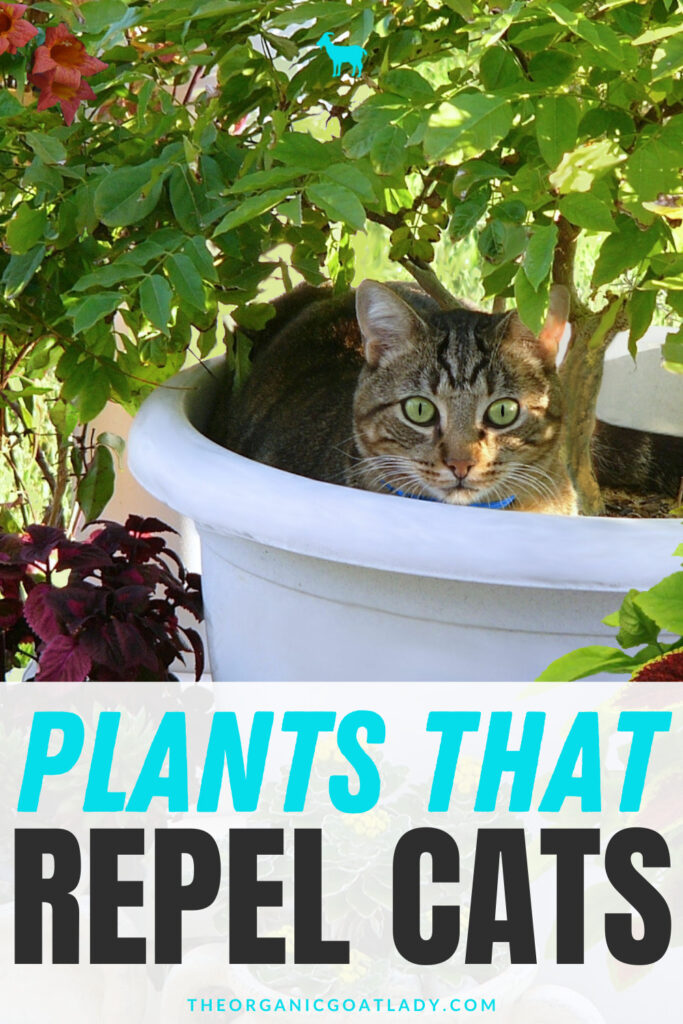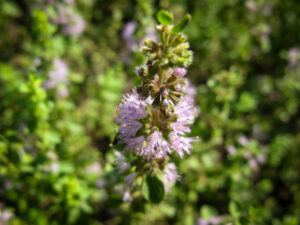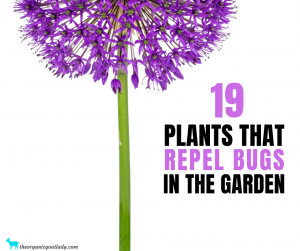Are you trying to find an effective cat repellent for neighborhood cats? Are you wondering what plants repel cats? Here is a list of cat-repellent plants!
This site contains affiliate links. If you make a purchase using one of these links, I may earn a commission. Please click here for more information about cookies collected and our privacy policy.

What plants repel cats?
If you are having a problem with stray cats in your yard or garden or if feral cats are bothering your backyard chickens then try planting some of these plants to repel them!
Cats can be deterred from certain areas or garden beds by planting plants that they find unappealing or offensive due to their scent or texture. Here are some plants that are known to repel cats:
1. Lavender (Lavandula angustifolia): Cats often dislike the strong scent of lavender.

Lavender (Lavandula angustifolia) is a fragrant herb that is known to repel cats due to its strong scent, which cats typically find unpleasant. An added bonus of using lavender is that you will also get to enjoy the pretty purple flowers! Here are some tips on using lavender to deter cats:
1. Plant Lavender Around Problem Areas: To deter cats from specific areas in your garden or yard, plant lavender around the perimeter. This can create a barrier of scent that cats may avoid.
2. Lavender Potpourri or Sachets: Consider placing dried lavender flowers in sachets or bags and strategically placing them in areas where you want to discourage cats from visiting. Replace the sachets as needed to maintain the scent.
3. Lavender Essential Oil: You can mix a few drops of lavender essential oil with water in a spray bottle and lightly mist areas you want to protect. Cats tend to dislike the smell, and this can be an effective deterrent. However, be cautious not to saturate the area or harm plants.
4. Lavender Hedges or Borders: Create hedges or borders using lavender plants to naturally repel cats from certain parts of your garden.
5. Lavender Pot Cultivation: If you have potted plants, consider placing potted lavender strategically around the area you want to protect.
6. Fresh Lavender Sprigs: Cats often dislike the texture of fresh lavender sprigs. You can try placing them in areas where cats tend to dig or frequent.
Remember that while lavender can be effective at repelling cats, its effectiveness may vary from cat to cat. Some cats may be less deterred by the scent than others. Additionally, lavender is generally safe for the environment and non-toxic to cats, making it a relatively safe option for cat deterrence in gardens and outdoor spaces.
2. Rosemary (Rosmarinus officinalis): Rosemary has a strong aroma that cats tend to avoid.

Rosemary (Rosmarinus officinalis) is a fragrant herb that can be used to help repel cats from certain areas in your garden or outdoor space due to its strong aroma, which cats often find unpleasant. It is also a very useful herb to include in your herb garden and has many culinary uses! Here’s how you can use rosemary to deter cats:
1. Plant Rosemary Around Problem Areas: To discourage cats from specific areas in your garden or yard, plant rosemary shrubs or bushes around the perimeter. This can create a barrier of scent that cats may avoid.
2. Rosemary in Pots: If you don’t want to plant rosemary directly in the ground, you can grow it in pots and strategically place the pots in areas where you want to deter cats.
3. Rosemary Sprigs: Place fresh rosemary sprigs in areas where cats tend to dig or frequent. Cats often dislike the texture of the rosemary leaves.
4. Rosemary Essential Oil: Mix a few drops of rosemary essential oil with water in a spray bottle and lightly mist areas you want to protect. Cats typically dislike the scent, and this can act as an effective deterrent. However, be careful not to saturate the area or harm plants.
5. Rosemary Mulch: Consider using rosemary clippings or trimmings as mulch around plants that you want to protect. This can release the scent of rosemary into the air and deter cats.
Remember that while rosemary can be an effective natural cat repellent, its effectiveness may vary from cat to cat. Some cats may be less deterred by the scent than others. Additionally, rosemary is generally safe for the environment and non-toxic to cats, making it a relatively safe option for cat deterrence in gardens and outdoor spaces.
Cat-Repelling Properties
3. Coleus canina (Scaredy Cat Plant): This plant is specifically bred to repel cats and dogs with its pungent odor.

The Coleus canina, commonly known as the “Scaredy Cat Plant” or “Pee-off Plant,” is specifically bred to repel cats and dogs with its strong odor. Here’s how you can use Coleus canina to deter cats:
1. Planting Coleus Canina: To discourage cats from specific areas in your garden or yard, plant Coleus canina around the perimeter. This can create a barrier of scent that cats may find unpleasant.
2. Potted Coleus Canina: If you don’t want to plant it directly in the ground, you can grow Coleus canina in pots and strategically place the pots in areas where you want to deter cats.
3. Maintenance: Coleus canina requires proper care and maintenance to continue emitting its repellent scent. Prune the plants regularly to encourage bushy growth and release more of the scent.
4. Refresh the Scent: The effectiveness of Coleus canina may diminish over time. To maintain its repellent properties, you can gently bruise or crush the leaves occasionally to release the scent.
5. Replant Annually: Depending on the climate and growth conditions, you may need to replant Coleus canina annually to ensure its effectiveness.
It’s important to note that while Coleus canina is specifically bred as a cat repellent plant, its effectiveness may vary from cat to cat. Some cats may be more deterred by its scent than others. Additionally, ensure that the plant is suitable for your local climate and growing conditions, as it may not thrive in extremely cold or hot environments.
4. Lemon balm (Melissa officinalis): Cats tend to dislike the lemony scent of this herb.

Lemon balm (Melissa officinalis) is an herb that has a lemony scent, which can be used to help repel cats from certain areas in your garden or outdoor space. Here’s how you can use lemon balm to deter cats:
1. Plant Lemon Balm: To discourage cats from specific areas in your garden or yard, plant lemon balm in those locations. This can create a barrier of scent that cats may find unpleasant.
2. Lemon Balm in Pots: If you don’t want to plant lemon balm directly in the ground, you can grow it in pots and strategically place the pots in areas where you want to deter cats.
3. Lemon Balm Sprigs: Place fresh lemon balm sprigs in areas where cats tend to dig or frequent. Cats often dislike the texture of the lemon balm leaves.
4. Lemon Balm Essential Oil: Mix a few drops of lemon balm essential oil (also known as melissa essential oil) with water in a spray bottle and lightly mist areas you want to protect. Cats typically dislike the scent, and this can act as an effective deterrent. However, be careful not to saturate the area or harm plants.
5. Lemon Balm Tea Bags: You can also use lemon balm tea bags placed strategically around the area. Cats often dislike the scent of the dried leaves.
Remember that while lemon balm can be an effective natural cat repellent, its effectiveness may vary from cat to cat. Some cats may be less deterred by the scent than others. Additionally, lemon balm is generally safe for the environment and non-toxic to cats, making it a relatively safe option for cat deterrence in gardens and outdoor spaces.
5. Rue (Ruta graveolens): Rue has a strong, bitter scent that can deter cats.

Rue (Ruta graveolens) is an herb known for its strong, bitter scent, which can be used to help repel cats from certain areas in your garden or outdoor space. Here’s how you can use rue to deter cats:
1. Plant Rue: To discourage cats from specific areas in your garden or yard, plant rue in those locations. Rue’s pungent scent can create a barrier that cats may find unpleasant.
2. Rue in Pots: If you don’t want to plant rue directly in the ground, you can grow it in pots and strategically place the pots in areas where you want to deter cats.
3. Rue Sprigs: Place fresh rue sprigs in areas where cats tend to dig or frequent. Cats often dislike the scent of the rue leaves.
4. Rue Essential Oil: You can also mix a few drops of rue essential oil with water in a spray bottle and lightly mist areas you want to protect. Cats typically dislike the scent, and this can act as an effective deterrent. Be cautious not to saturate the area or harm plants.
5. Dry Rue Herb: Consider using dried rue herb placed strategically around the area. Cats often find the scent of dried rue unappealing.
It’s important to note that while rue can be an effective natural cat repellent, its effectiveness may vary from cat to cat. Some cats may be less deterred by the scent than others. Additionally, rue can be toxic if ingested in large quantities, so be cautious when using it in areas accessible to pets. It’s generally safer to use rue as a deterrent in areas where cats won’t come into direct contact with the plant or its parts.
Natural Repellent
6. Pennyroyal (Mentha pulegium): Pennyroyal has a strong minty scent that can repel cats.

Pennyroyal (Mentha pulegium) is an herb that has a strong minty scent, and it has been used to repel cats and other animals due to its aroma. Pennyroyal is a member of the mint family. Here’s how you can use pennyroyal to deter cats:
1. Plant Pennyroyal: To discourage cats from specific areas in your garden or yard, plant pennyroyal in those locations. Pennyroyal’s strong minty scent can create a barrier that cats may find unpleasant.
2. Pennyroyal in Pots: If you don’t want to plant pennyroyal directly in the ground, you can grow it in pots and strategically place the pots in areas where you want to deter cats.
3. Pennyroyal Sprigs: Place fresh pennyroyal sprigs in areas where cats tend to dig or frequent. Cats often dislike the texture of the pennyroyal leaves.
4. Pennyroyal Essential Oil: Mix a few drops of pennyroyal essential oil with water in a spray bottle and lightly mist areas you want to protect. Cats typically dislike the scent, and this can act as an effective deterrent. Be careful not to saturate the area or harm plants.
5. Dry Pennyroyal Herb: You can also use dried pennyroyal herb placed strategically around the area. Cats often find the scent of dried pennyroyal unappealing.
It’s important to note that while pennyroyal can be an effective natural cat repellent, its effectiveness may vary from cat to cat. Some cats may be less deterred by the scent than others. Additionally, pennyroyal should be used with caution because it contains a substance called pulegone that can be toxic to both cats and humans if ingested in large quantities. Therefore, it’s generally safer to use pennyroyal as a deterrent in areas where cats won’t come into direct contact with the plant or its parts.
7. Citronella (Pelargonium citrosum): Citronella plants have a lemony scent that is unpleasant to cats.

Citronella (Pelargonium citrosum) is a plant known for its strong lemony scent, which is often used to repel mosquitoes and other insects. While citronella is primarily used as an mosquito plant, some people have reported success in using it to deter cats as well. Here’s how you can use citronella to help repel cats:
1. Plant Citronella: To discourage cats from specific areas in your garden or yard, plant citronella in those locations. Citronella’s strong lemony scent can create a barrier of fragrance that cats may find unpleasant.
2. Citronella in Pots: If you don’t want to plant citronella directly in the ground, you can grow it in pots and strategically place the pots in areas where you want to deter cats.
3. Citronella Oil: You can also use citronella essential oil. Mix a few drops of citronella essential oil with water in a spray bottle and lightly mist areas you want to protect. Cats typically dislike the scent, and this can act as an effective deterrent. Be careful not to saturate the area or harm plants.
4. Citronella Candles: Citronella candles, while primarily used to repel mosquitoes, can also release a lemony scent that cats may find unappealing. Place these candles in areas you want to protect, but be cautious about using them in dry or windy conditions to avoid fire hazards.
5. Citronella-Based Cat Repellent Sprays: Some commercially available cat repellent sprays contain citronella as an active ingredient. You can use these sprays on surfaces or areas you want to keep cats away from.
Keep in mind that while citronella may help deter cats, its effectiveness can vary from cat to cat. Some cats may be less bothered by the scent than others. Additionally, citronella is generally safe for the environment and non-toxic to cats, making it a relatively safe option for cat deterrence in gardens and outdoor spaces.
8. Marigolds (Tagetes spp.): The strong scent of marigolds can deter cats from gardens.

Marigolds (Tagetes spp.) are colorful annual flowers that can serve as a natural deterrent for cats in gardens and outdoor areas. Here’s how you can use marigolds to help repel cats:
1. Plant Marigolds: To discourage cats from specific areas in your garden or yard, plant marigolds in those locations. Marigolds have a strong scent that many cats find unpleasant, particularly when they come into contact with the leaves or flowers.
2. Marigolds in Pots: If you don’t want to plant marigolds directly in the ground, you can grow them in pots and strategically place the pots in areas where you want to deter cats.
3. Marigold Borders: Create borders or edges around garden beds using marigolds. This can help keep cats away from your plants and flowers.
4. Interplanting: Intermingle marigolds with other plants that you want to protect from cats. The scent of marigolds may act as a natural deterrent.
5. Marigold Varieties: While most marigold varieties have a strong scent, French marigolds (Tagetes patula) and African marigolds (Tagetes erecta) are particularly known for their pungent aroma.
6. Regular Maintenance: Keep your marigold plants healthy by providing them with adequate water and sunlight. Prune them as needed to encourage bushy growth and the release of their scent.
While marigolds can be an effective natural cat repellent, it’s important to note that their effectiveness may vary from cat to cat. Some cats may be less deterred by the scent than others. Additionally, marigolds are generally safe for the environment and non-toxic to cats, making them a relatively safe option for cat deterrence in gardens and outdoor spaces.
Cat Repellent Plants
9. Rose bushes (Rosa spp.): The thorns on rose bushes can make it uncomfortable for cats to navigate.

Rose bushes (Rosa spp.) can serve as a natural deterrent for cats in gardens and outdoor areas due to their thorns and prickly stems. Here’s how you can use rose bushes to help repel cats:
1. Plant Thorny Rose Bushes: Choose rose varieties that have sharp thorns and prickly stems, such as rugosa roses or some climbing roses. Plant these roses strategically in areas where you want to deter cats.
2. Create a Barrier: Plant a row of thorny rose bushes in thorny hedges as a physical barrier around garden beds or other areas you want to protect from cats. The thorns can make it uncomfortable for cats to approach or enter these areas.
3. Mixed Plantings: Interplant thorny rose bushes with other plants that you want to protect. The presence of the roses can discourage cats from getting too close.
4. Regular Pruning: Keep your rose bushes well-maintained by regularly pruning and shaping them. Pruned rose bushes can have denser, thornier growth, which may be more effective in deterring cats.
5. Use Mulch or Gravel: Applying a layer of gravel or mulch around the base of rose bushes can make it less inviting for cats to dig in the soil.
6. Monitor and Maintain: Keep an eye on your rose bushes to ensure they are healthy and continue to provide a deterrent effect. Replace any damaged or diseased plants as needed.
It’s important to note that while thorny rose bushes can be an effective deterrent for cats, they may not completely prevent cats from entering an area. Additionally, be cautious when using thorny plants in areas accessible to children and pets, as the thorns can pose a risk of injury. Prune the roses carefully to remove any dead or damaged branches and thorns to reduce the risk of accidental injuries.
10. Prickly pear cactus (Opuntia spp.): The spines on prickly pear cactus can discourage cats from entering certain areas.

Prickly pear cactus (Opuntia spp.) is a type of cactus known for its sharp spines and thorny pads. While it may not be a traditional choice for deterring cats, these prickly plants can serve as a physical barrier to keep cats away from certain areas in your garden or outdoor space. Here’s how you can use prickly pear cactus to help repel cats:
1. Plant Prickly Pear Cactus: To discourage cats from specific areas in your garden or yard, plant prickly pear cactus in those locations. The sharp spines and thorny pads can make it uncomfortable for cats to approach or enter these areas.
2. Create a Cactus Barrier: Plant a row of prickly pear cacti as a physical barrier around garden beds, flower beds, or other areas you want to protect from cats. Ensure the cacti are spaced closely to create an effective deterrent.
3. Mixed Plantings: Interplant prickly pear cactus with other plants that you want to protect. The presence of the cactus can discourage cats from getting too close.
4. Regular Maintenance: Keep your prickly pear cacti well-maintained by periodically removing dead or damaged pads and ensuring they have sufficient sunlight and well-drained soil.
5. Use Caution: Be cautious when using prickly pear cactus in areas accessible to children and pets, as the spines and thorns can cause injuries. Consider placing the cactus in areas that are not frequented by people or pets to minimize the risk.
It’s important to note that while prickly pear cactus can be an effective physical deterrent for cats, it may not completely prevent cats from entering an area. Additionally, the spines and thorns of prickly pear cactus can be harmful to cats and other animals, so use it with care and consider the safety of wildlife and other pets in your area.
13. Geraniums (Pelargonium spp.): Certain types of geraniums, such as citronella geraniums, can deter cats with their strong scent.

Geraniums (Pelargonium spp.) are popular flowering plants that some people believe can help repel cats from gardens and outdoor areas. The strong scent of certain geranium varieties, such as citronella geraniums (Pelargonium citrosum), can be unpleasant to cats and may deter them from entering specific areas. Here’s how you can use geraniums to help repel cats:
1. Plant Citronella Geraniums: To discourage cats from specific areas in your garden or yard, consider planting citronella geraniums in those locations. These geraniums are known for their lemony scent, which cats often find unpleasant.
2. Regular Maintenance: Keep your geranium plants well-maintained by deadheading (removing spent flowers) and providing them with proper care. Healthy geraniums are more likely to release their scent effectively.
3. Use in Containers: You can also grow citronella geraniums in pots and place them strategically in areas where you want to deter cats.
4. Replace Annually: Depending on your climate and the growth conditions, you may need to replant citronella geraniums annually to ensure their effectiveness.
It’s important to note that while citronella geraniums can be an effective natural cat repellent, their effectiveness may vary from cat to cat. Some cats may be less deterred by the scent than others. Additionally, geraniums are generally safe for the environment and non-toxic to cats, making them a relatively safe option for cat deterrence in gardens and outdoor spaces.
14. Alliums (Allium spp.): Plants like garlic, onions, and chives have a strong smell that cats generally dislike.
Alliums, which include plants like garlic, onions, and chives (Allium spp.), have a strong odor that some people believe can help repel cats from gardens and outdoor areas. While alliums are primarily grown for culinary purposes, their pungent scent may deter cats from certain areas. Here’s how you can use alliums to help repel cats:
1. Plant Alliums: To discourage cats from specific areas in your garden or yard, consider planting alliums, such as garlic or chives, in those locations. Cats often find the strong smell of alliums unpleasant.
2. Interplant with Other Plants: Intermingle alliums with other plants that you want to protect from cats. The presence of alliums can discourage cats from getting too close.
3. Regular Maintenance: Keep your allium plants well-maintained by providing them with proper care and harvesting them as needed. Healthy alliums are more likely to release their scent effectively.
4. Replace Annually: Depending on your climate and growing conditions, you may need to replant alliums annually to ensure their effectiveness.
It’s important to note that while alliums may help deter cats, their effectiveness can vary from cat to cat. Some cats may be less deterred by the scent than others. Additionally, alliums are generally safe for the environment and non-toxic to cats when grown in small quantities. However, if ingested in large quantities, some allium species can be toxic to cats, so it’s essential to plant them in moderation and avoid overexposure.
15. Thorny Bushes and Shrubs: While not plants per se, thorny bushes and shrubs like barberry (Berberis spp.) or pyracantha can create physical barriers that deter cats from entering specific areas.
Thorny bushes and shrubs can be effective at repelling cats due to their prickly and uncomfortable texture. Here are some thorny bushes and shrubs you can consider planting to help deter cats from specific areas in your garden or yard:
1. Barberry (Berberis spp.): Barberry bushes have sharp thorns along their branches, which can create a barrier to keep cats away from certain areas.
2. Pyracantha (Pyracantha spp.): Pyracantha, also known as firethorn, has thorny branches and can be used to create a natural deterrent against cats.
3. Roses (Rosa spp.): As mentioned above, various rose varieties, such as climbing roses and rugosa roses, have sharp thorns and can be planted to create a thorny barrier.
4. Holly (Ilex spp.): Holly shrubs typically have spiky leaves and can be used to deter cats from entering specific areas.
5. Hawthorn (Crataegus spp.): Hawthorn shrubs and trees have thorns and can serve as a natural deterrent.
6. Blackberry (Rubus fruticosus): Blackberry bushes have thorns and can be planted to create a barrier that cats may avoid.
7. Gooseberry (Ribes uva-crispa): Gooseberry bushes have spiky stems and can be effective at deterring cats.
8. Raspberries (Rubus idaeus): Raspberry canes have thorns that can discourage cats from entering certain areas.
When using thorny bushes and shrubs to repel cats, consider the following:
– Proper Placement: Plant these thorny plants strategically in areas where you want to deter cats from digging, entering flower beds, or causing damage.
– Regular Maintenance: Keep the thorny plants well-maintained by pruning and shaping them. Pruned bushes can have denser, thornier growth.
– Safety: Be cautious when using thorny plants in areas accessible to children and pets, as the thorns can cause injuries. Prune the plants carefully to remove any dead or damaged branches and thorns to reduce the risk of accidental injuries.
While thorny bushes and shrubs can be effective at deterring cats, they may not completely prevent cats from entering an area. Combining them with other deterrent methods, such as those listed below, can enhance their effectiveness in keeping cats away.
Keep in mind that while these plants may help deter cats, their effectiveness can vary from cat to cat. Additionally, it’s important to ensure that any plants you use are safe for your garden and the environment. Some plants can be toxic to pets if ingested, so always research the plants you plan to use and consider the safety of other animals and wildlife in your area. Additionally, if you’re trying to deter cats from digging or using a specific area as a litter box, you may need to use additional methods such as physical barriers or deterrent sprays.
Keep in mind that while these plants can help deter cats, there is no guarantee that they will be 100% effective, as individual cat preferences can vary. Using a combination of these plants, physical barriers, and other deterrent methods may be the most effective approach to keep cats out of specific areas. Additionally, it’s essential to ensure the plants you choose are safe for your garden and the environment, and that they are planted in a way that does not harm other wildlife or pets.
Additional Effective Cat Deterrents
In addition to the specific plants and methods mentioned earlier, here are some additional ways to repel cats from your garden or outdoor space:
1. Cat Repellent Sprays: Commercial cat repellent sprays are available and can be applied to specific areas you want to protect. These sprays often contain natural scents that cats find unpleasant, such as citrus or garlic.
2. Motion-Activated Devices: Motion-activated devices like motion-activated sprinklers, lights, or noise-emitting devices can startle and deter cats when they enter a protected area.
3. Aluminum Foil or Sticky Tape: Cats often dislike the texture of aluminum foil or sticky tape. Place strips of foil or tape in areas where cats are a problem, and they may avoid walking on or near it.
4. Cayenne Pepper or Ground Coffee: Sprinkle cayenne pepper or used coffee grounds in areas where cats are digging or entering. Cats typically dislike the smell.
5. Chicken Wire or Netting: Lay down chicken wire or netting on the soil surface in garden beds or around plants to discourage cats from digging. Be sure to secure it so that it doesn’t harm the plants.
6. Ultrasonic Repellents: Install ultrasonic devices that emit high-pitched sounds not audible to humans but annoying to cats when they approach. These devices can be effective in keeping cats away.
7. Physical Barriers: Use fencing, netting, or garden mesh to create barriers that prevent cats from accessing certain areas.
8. Remove Attractants: Eliminate food sources, like bird feeders or open garbage cans, that might attract cats to your yard.
9. Outdoor Furniture Covers: Cats may be attracted to soft outdoor furniture for scratching. Use covers or tarps to protect your outdoor furniture when not in use.
10. Regular Garden Maintenance: Keep your garden well-maintained, removing fallen leaves, twigs, and debris that might attract cats for digging or hiding.
Remember that what works as a cat repellent can vary depending on individual cat behavior and preferences. It may require some trial and error to find the most effective combination of deterrent methods for your specific situation. Additionally, always prioritize safe and humane methods when dealing with cats or any other animals in your outdoor space.
Plants That Repel
If you are looking to repel other animals from your yard and garden be sure to check out:








